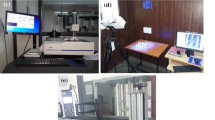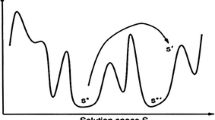Abstract
In this paper an artificial neural network (ANN) aiming for the efficient modelling of a set of machining conditions for orthogonal cutting of polyetheretherketone (PEEK) composite materials is presented. The supervised learning of the ANN is based on a genetic algorithm (GA) supported by an elitist strategy. Input, hidden and output layers model the topology of the ANN. The weights of the synapses and the biases for hidden and output nodes are used as design variables in the ANN learning process. Considering a set of experimental data, the mean relative error between experimental and numerical results is used to monitor the learning process obtaining the completeness of the machining process modelling. Also a regularization term associated to biases in hidden and output neurons are included in the GA fitness function for learning. Using a different set of experimental results, the optimal ANN obtained after learning is tested. The optimal number of nodes on the hidden layer is searched and the positive influence of the regularization term is demonstrated. This approach of ANN learning based on GA presents low mean relative errors in learning and testing phases.
Similar content being viewed by others
References
Liu Q, Altintas Y (1999) On-line monitoring of flank wear in turning with multi-layered feed-forward neural network. Int J Mach Tool Manuf 39:1945–1959
Lin SC, Ting CJ (1996) Drill wear monitoring using neural network. Int J Mach Tool Manuf 36:465–475
Das S, Roy R, Chottopadhyay AB (1996) Evaluation of wear of turning carbide inserts using neuronal network. Int J Mach Tool Manuf 36:789–797
Choudhury SK, Jain VK, Rama Rao CVV (1999) On-line monitoring of tool wear in turning using neural network. Int J Mach Tool Manuf 39:489–504
Briceno J, El-Mounayri H, Mukhopadhyay S (2002) Selecting an artificial neuronal network for efficient modeling and accurate simulation of the milling process. Int J Mach Tool Manuf 42:663–674
Oktem H, Erzurumlu T, Erzincanli F (2006) Prediction of minimum surface roughness in end milling mold parts using neural network and genetic algorithm. Mater Design 27:735–744
Tsai YH, Chen JC, Lou SJ (1999) An in-process surface recognition system based on neural networks in end milling cutting operations. Int J Mach Tool Manuf 39:583–605
Suresh PVS, Rao PV, Deshmukh SG (2002) A genetic algorithmic approach for optimization of surface roughness prediction model. Int J Mach Tool Manuf 42:675–680
Zhecheva A, Malinov S, Sha W (2005) Simulation of microhardness profiles of titanium alloys after surface nitriding using artificial neural network. Surface Coat Technol 200:2332–2342
Altinkok N, Koker R (2006) Modelling of the prediction of tensile and density properties in particle reinforced metal matrix composites by using neural networks. Mater Design 27:625–631
Childs TH, Maekawa K, Obikawa T, Yamane Y (2000) Metal machining: theory and application. Edward Arnold, London, pp 35–80
Mok SL, Kwong CK, Lau WS (2001) A hybrid neural network and genetic algorithm approach to the determination of initial process parameters for injection molding. Adv Manuf Technol 18:404–409
Nakhjavani OB, Ghoreishi M (2006) Multi criteria optimization of laser percussion drilling process using artificial neural network model combined with genetic algorithm. Mater Manuf Process 21:11–18
António CC, Castro CF, Sousa LC (2004) Optimisation of metal forming processes. Comput Struct 82:1425–1433
Spears WM, DeJong SK (1991) On the virtues of parametrized uniform crossover. In: Belew RK, Booker LB (eds) Proceedings of Fourth International Conference on Genetic Algorithms. Morgan Kaufmann, pp 230–236
Conceição António CA, Paulo Davim J (2002) Optimal cutting conditions in turning of particulate metal matrix composites based on experiment and a genetic search model. Compos Part A Appl Sci Manuf 33(2):213–219
Author information
Authors and Affiliations
Corresponding author
Rights and permissions
About this article
Cite this article
António, C.A.C., Davim, J.P. & Lapa, V. Artificial neural network based on genetic learning for machining of polyetheretherketone composite materials. Int J Adv Manuf Technol 39, 1101–1110 (2008). https://doi.org/10.1007/s00170-007-1304-5
Received:
Accepted:
Published:
Issue Date:
DOI: https://doi.org/10.1007/s00170-007-1304-5




